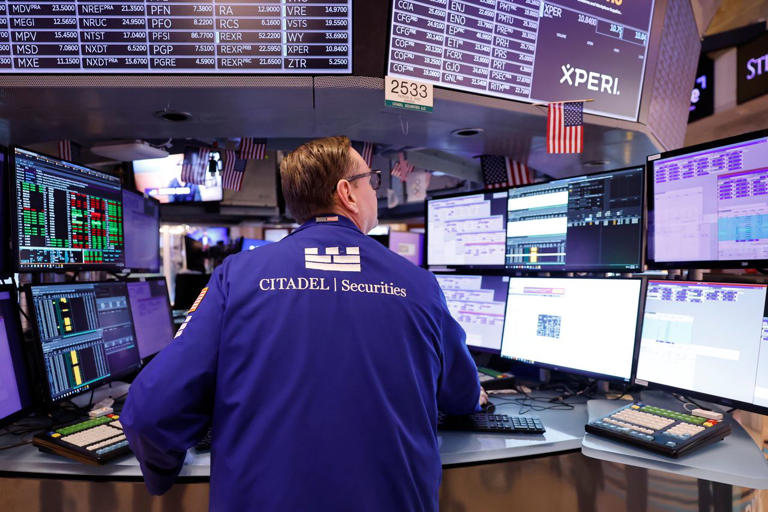Stock bulls had reason to celebrate this week as all three major U.S. equity indexes posted gains of at least 1.3%, marking the sixth weekly increase in the first eight weeks of 2024. Both the S&P 500 and Dow Jones Industrial Average closed at new record highs on Thursday, repeating the feat on Friday. Notably, the Dow surpassed the 39,000 mark for the first time on Thursday.
Nvidia’s Wednesday-evening earnings report ignited excitement among technology investors, propelling the chip maker’s shares to surge by 17% over the following two trading days. Nvidia’s quarterly sales and forecast surpassed Wall Street expectations, briefly propelling its market valuation above $2 trillion on Friday.
Following a stellar performance in 2023, the stock market has continued its upward trajectory in 2024, with the S&P 500 and Nasdaq both posting approximately 7% gains so far this year. Unlike previous rallies driven by expectations of interest rate cuts, the current surge is attributed to robust earnings reports.
Earlier hopes of interest rate cuts, which buoyed stocks last fall, have waned as central bank officials have signaled caution about reducing rates prematurely, fearing it could exacerbate inflationary pressures. Consequently, market expectations for rate cuts have been pushed back.
Federal Reserve officials have effectively ruled out a rate cut in March, emphasizing a “no need to rush” approach in both the minutes from the Fed’s last meeting and in recent statements.
Quincy Krosby, chief global strategist at LPL Financial, noted the market’s satisfaction with strong earnings, shifting focus away from potential rate cuts. While the market still anticipates rate cuts in the future, the timing remains uncertain, allowing the euphoria surrounding artificial intelligence (AI) to continue driving markets higher.
Next week’s release of the personal-consumption expenditures index, the Fed’s preferred inflation gauge, will be closely monitored for insights into price pressures and the Fed’s policy direction. Recent data showing higher-than-expected consumer inflation and job numbers may provide the Fed with more flexibility to delay rate cuts.
Currently, attention is squarely on artificial intelligence, with analysts expressing bullish sentiment towards the trend and stocks in general following Nvidia’s earnings report. The report affirmed significant demand for AI chips from tech companies, leading some analysts to believe that the AI boom is sustainable.
Solita Marcelli, chief investment officer for the Americas at UBS Global Wealth Management, highlighted generative AI as a growth theme of the decade and raised the year-end forecast for the S&P 500. UBS estimates that AI industry revenues will grow by approximately 70% annually until 2027.
Despite Nvidia’s rapid ascent to a market value of about $2 trillion, some investors are concerned about the stock being priced for perfect future performance. However, few are actively betting against it at this time.
“AI is transformative in ways we can’t predict,” remarked Chris Marangi, co-chief investment officer of value at Gabelli Funds. He emphasized Nvidia as one of the few clear winners effectively capitalizing on the AI boom, advising against opposing its momentum.
Market gains remain concentrated among the “Magnificent Seven,” a group comprising Alphabet, Amazon.com, Apple, Meta Platforms, Microsoft, Tesla, and Nvidia. While this concentration raises concerns about index vulnerability to the performance of a handful of companies, it also fuels optimism for further growth potential, depending on one’s perspective.
“We believe the rally will broaden. It actually already has,” stated Nancy Tengler, chief executive of Laffer Tengler Investments. Tengler views the rapid technological advancements expected from AI as a “fourth industrial revolution” and anticipates continued momentum for Magnificent Seven stocks over several years.
Despite the overall positive sentiment, trading activity was relatively subdued on Friday, with the S&P 500 inching up by less than 0.1% and the Dow rising 0.2%. The Nasdaq, after surging 3% on Thursday—its largest one-day jump in a year—edged down by 0.3%.
Palo Alto Networks emerged as the top performer in the S&P 500 on Friday, rebounding by 5.3% following a revenue forecast cut earlier in the week. Conversely, Warner Bros. Discovery faced a setback, dropping by 9.9% after missing revenue and earnings expectations.
In the bond market, Treasury yields declined, with the yield on the benchmark 10-year note falling to 4.258%. Traders in interest-rate derivatives overwhelmingly anticipate the Fed to maintain its benchmark rate steady until at least the June meeting, with a 56% chance of a cut, according to CME Group’s FedWatch tool.
Internationally, the Stoxx Europe 600 closed at a new record on Thursday and repeated the feat on Friday, rising by 1.2% for the week. Meanwhile, Japan’s Nikkei, having reached a record high for the first time in 34 years, was closed for a holiday.
